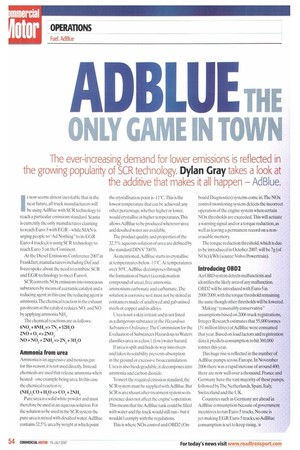ADBLIJE THE
Page 54

If you've noticed an error in this article please click here to report it so we can fix it.
ONLY GAME IN TOWN
The ever-increasing demand for lower emissions is reflected in the growing popularity of SCR technology. Dylan Gray takes a look at the additive that makes it all happen — AdBlue.
It now seems almost inevitable that in the near future, all truck manufacturers will be using AdBlue with SCR technology to reach a particular emissions standard. Scania is currently the only manufacturer claiming to reach Euro-5 with EGR — while MAN is urging people to"Ad Nothing" to its EGR Euro-4 trucks, it is using SCR technology to reach Euro-5 on the Continent.
At the Diesel Emissions Conference 2007 in Frankfurt, manufacturers including Daf and Iveco spoke about the need to combine SCR and EGR technology to meet Euro-6.
SCR converts NOx emissions into innocuous substances by means of a ceramic catalyst and a reducing agent; in this case the reducing agent is ammonia.The chemical reaction in the exhaust gas stream at the catalyst reduces NO, and NO by applying ammonia NH3.
The chemical reactions are as follows: 6NO2 +8NH,=> 7N, + 121420 2NO + 0, =>2NO, NO + NO, +2NH,=> 2N, + 311,0 Ammonia from urea
Ammonia is an aggressive and noxious gas; for this reason, it is not used directly. Instead chemicals are used that release ammonia when heated — one example being urea. In this case the chemical reaction is: (NH2)2C0 + H10 => CO, + 2N113 Pure urea is a solid white powder and must therefore be used in an aqueous solution. For the solution to be used in the SCR system the pure urea is mixed with desalted water, AdBlue contains 32.5% urea by weight at which point the crystallisation point is -11"C. This is the lowest temperature that can be achieved:any other percentage, whether higher or lower, would crystallise at higher temperatures.This allows AdBlue to be produced wherever urea and desalted water are available.
The product quality and properties of the 32.5% aqueous solution of urea are defined by the standard DIN V 70070.
As mentioned,AdBlue starts to crystallise at temperatures below -1 I C. At temperatures over 50C, AdBlue decomposes through the formation of biuret (a condensation compound of urea), free ammonia, ammonium carbonate and carbamate. The solution is corrosive so it must not be stored in containers made of unalloyed and galvanised steels or copper and its alloys.
Urea is not a skin irritant and is not listed as a dangerous substance in the Hazardous Substances Ordinance.The Commission for the Evaluation of Substances Hazardous to Waters classifies urea as a class I (low) water hazard.
If urea is spilt and finds its way into rivers and lakes its solubility prevents absorption in the ground or excessive bioaccumulation. Urea is also biodegradable; it decomposes into ammonia and carbon dioxide.
To meet the required emission standard, the SCR system must be supplied with AdBlue. But SCR is an exhaust after-treatment system so its presence does not affect the engine's operation. This means that the Ad Blue tank could be filled with water and the truck would still run—but it wouldn't comply with the regulations.
This is where NOx control and OBD2 (On board Diagnostics) systems come in.The NOx control monitoring system detects the incorrect operation of the engine system when certain NOx thresholds are exceeded. This will actuate a warning signal and/or a torque reduction, as well as leaving a permanent record on a nonerasable memory The torque reduction threshold, which is due lobe introduced in October 2007, will be 7g (of NOx)/kWh (source:Volvo Powertrain).
Introducing OBD2
An OBD system detects malfunctions and identifies the likely area of any malfunction. OBD2 will be introduced with Euro-5 in 2008/2009, with the torque threshold remaining the same though other thresholdswillbe lowered.
Making "reasonably conservative" assumptions based on 2006 truck registrations, Integer Research estimates that 55,000 tonnes (51 million litres) of AdBlue were consumed that year. Based on load factors and registration data it predicts consumption to hit 360,000 tonnes this year.
This huge rise is reflected in the number of AdBlue pumps across Europe. In November 2006 there was a rapid increase of around 400; there are now well over a thousand.France and Germany have the vast majority of these pumps, followed byThe Netherlands, Spain, Italy, Switzerland and the UK.
Countries such as Germany are ahead in AdBlue consumption because of government incentives to run Euro-5 trucks. No one is yet making EGR Euro-5 trucks, so AdBlue consumption is set to keep rising.


























































































































































































